Pile Super Power
More than 600 thousand tons on the basement area of 5700 square meters ... It is unlikely that you will find in the world analogues of the St. Petersburg "Lakhta Center" parameters. Keep supertoll and heavyweight help piles. Uneasy. They do not lean, they hang.

Feel uncomfortable? Do not rush to bypass the construction site along a radius of 500 meters. Let us figure out how to get a reliable support from what is in the "hanging" position.
It was not by chance that I recalled this passage from an old Soviet film. How wrong are those who believe that a pile is a kind of “pillar”, simple and artless, like a potato tuber.
')
Today's piles are infinitely far from the great-grandfathers - wooden logs. They can be concrete, steel, reinforced concrete, combined materials. Hammer-in, indented, screwed in, drilled, stuffed, bored - in the way they get into the ground. They can be made in advance and loaded into the mine or manufactured directly in it. According to the method of work, the pile may be suspended or fixed. A modern pile is in itself a skillful engineering structure.

And you can still so. 1988 Experimental method of delivering piles to the ground - “shooting”, in this example - through the water. Army gun redeveloped for construction purposes. The depth of driving is increased 2-2.5 times per shot at “compared to using the same energy differently”.
Source of
And now let's complicate the task - piles work in a group - a pile field. Within the field, piling parameters may vary. The field recipe is prescribed by geotechnics - its own, in each individual case. In the case of the Lakhta Center Tower, a unique structure in the ground conditions of the third, most difficult category, this recipe was masterfully composed.
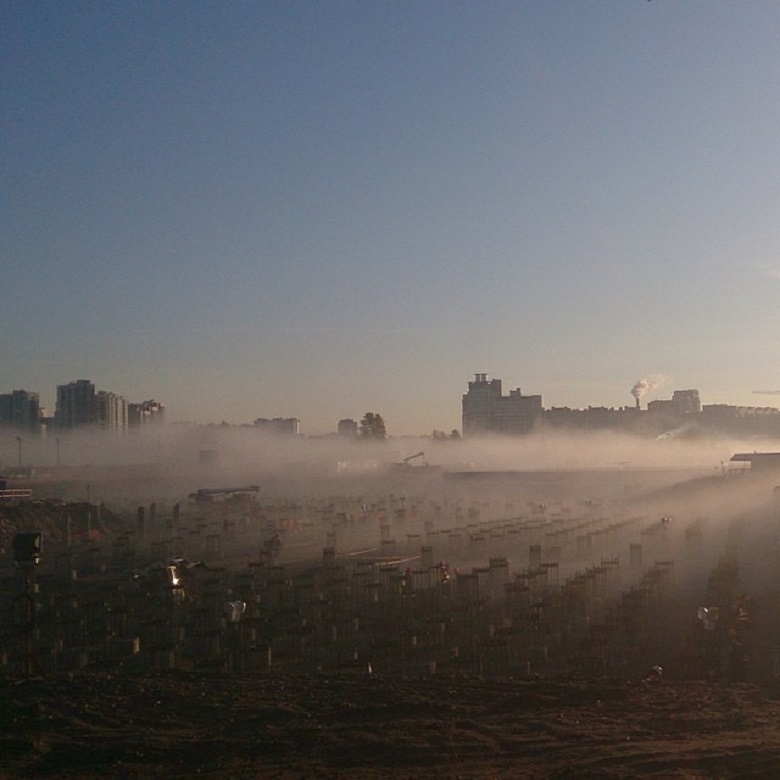
Fog over the pile field "Lakhta Center". 2013
For all the obvious answer, it is not obvious. High-rise buildings, in principle, can do without them. So far, the failed Ingria Tower skyscraper in St. Petersburg (165 m), which should be erected on Poklonnaya Hill, according to the project has no piles - only a slab. Of course, not from the good life: under the ground in this place is the zone of influence of the subway tunnels. Nevertheless, the company's calculations confirmed the reliability of the design, and later the decision was approved by Glavgosexpertiza.

The construction project has not been approved by Gosstroynadzor. Not because of the piles. The reason - the discrepancy Gradplan and "extra" underground floor. The authors of the project are “Tsaritsyn Architectural Studio”. Photo source
Maybe in Lakhta Center do without piles? Just make the slab more powerful and deeper?
The first thing geotechnics do when they receive the results of underground surveys is to answer this question. The verdict is unambiguous - building on a natural basis is impossible for Lakhta Center. Support layers - Vendian clay, located too deep. How not to deepen the base plate, they are still far away.
Even if the supporting layer was close - you can not do without piles. There is a reason.
Any building gives a draft. The mechanics of the process are easy to imagine - you sit on the sofa and push the pillow.
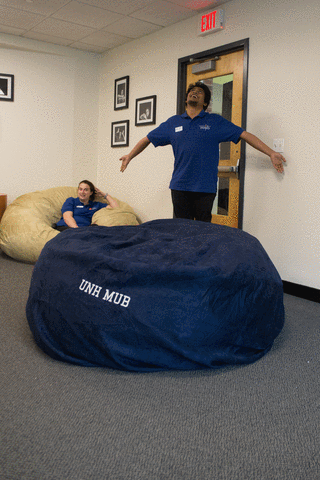
The building and the ground also work
The draft itself is not a threat. Problems begin only when it passes unevenly. The nightmare of any geotechnical engineer is a roll or deflection of the foundation to a supercritical state.
In the case of a supertoll, rates are rising. Not just because of the height of the tower.
In Lakhta Center, as in most modern skyscrapers, the main element of the sustainability system is the core.
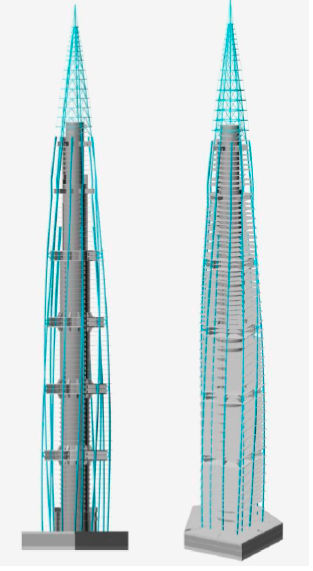
At the St. Petersburg tower it is reinforced concrete, very massive - the thickness of the wall is from 2.5 to 0.8 meters with thinning as it gains height. The diameter also decreases, the maximum radius is 26 meters at the base of the tower.
Most of the load on the foundation should fall on this 26-meter section.
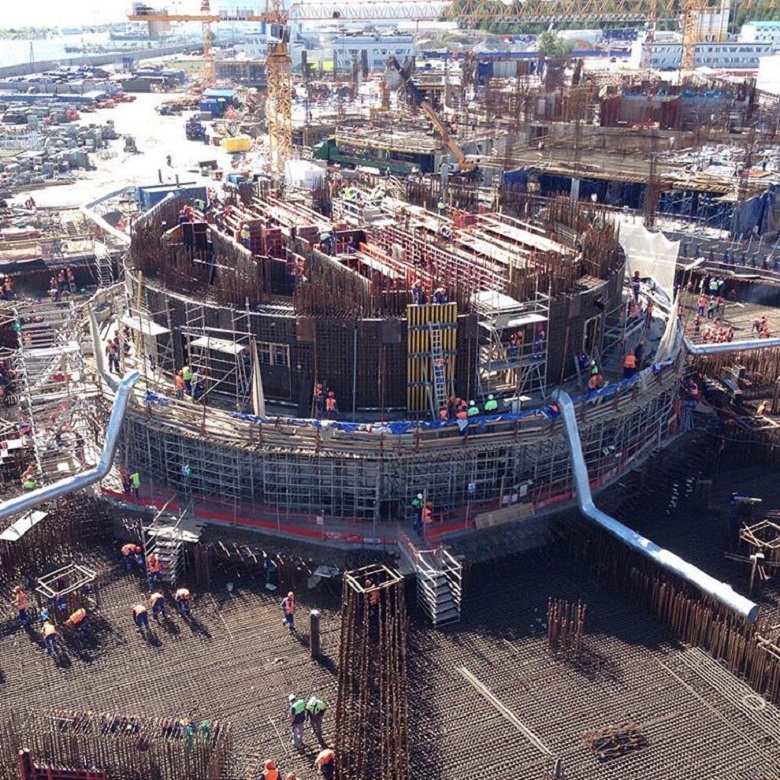
The core of "Lakhta Center" at the foundation level. 2015
The greatest pressure on the base - in the center, the least - on the edges. Solid base plate will sag. Of course, it will not turn into a “glass” - a supercritical state will occur at the “soup bowl” stage.
You can make the slab tougher - more reinforcement, more reinforced concrete, more strength! According to calculations, the required stiffness is achievable in a slab with a thickness of 8 meters.
There are no such monolithic slabs in the world. Skyscraper Messe Torhaus (Frankfurt) has 6-meter sections in the foundation. More such a feat no one repeated.

Messe Torhaus, 117 m. Photo Source
There is a reason that no one will ever make an 8 meter thick slab of concrete. Paradoxically, it simply will not be durable. This will occur due to the occurrence of cracks during the cooling of the concrete mix. It is hardly possible to control the process of exothermia on a monolith of such thickness.

Photos from instagrama Saratov plant concrete mixes. (The illustration is not a demonstration of the quality of the products of the plant - see instagram)
Messe was built in 1983-84, now there is a more effective technical solution - a box-like foundation. In order not to depart far from the pile theme, for the time being we simply take it as a fact - as a result, under the tower “Lakhta Center” the foundation is just that kind, box-shaped. How it works on the uniform distribution of loads, we will tell in a separate post.
Box-shaped foundation will not allow the plate to be like a soup bowl. But to achieve ideally the same pressure over the entire area of the base, he still can not afford. To prevent the "saucer" effect, a pile field enters the battle.
The first thing you need to know to create a uniform precipitation is how different areas are loaded under the base.
Let's look at the scheme.

Three load zones
The first surprise is that, thanks to the box-like foundation, under-center piles will now be under the center.
The zone of increased attention - the second, between the center and the periphery - a significant load from under the trunk of the building passed into this zone. Further - behind the contour of the building, on the periphery, the pressure weakens.
Now it is necessary to make so that all sites settle down synchronously. The orchestra will be conducted by geotechnics.
There are three parameters of piles that can be adjusted.
The first is the length. It increases the bearing capacity of the pile and slows the rate of precipitation. Behind the contour of the building are piles of 55 meters each. Inside - ten meters longer.
The second parameter is the pile pitch frequency. Under the core and in the periphery, it is equal to 5 meters. In the zone of concentration of the load "accelerates" to 3-4 meters.

Pile field under the tower. A dark badge denotes piles 65 meters long, 55 meters light.
The third is the width of the pile. It does not change - the diameter of all structures is 2 meters. These are the widest piles in the world.
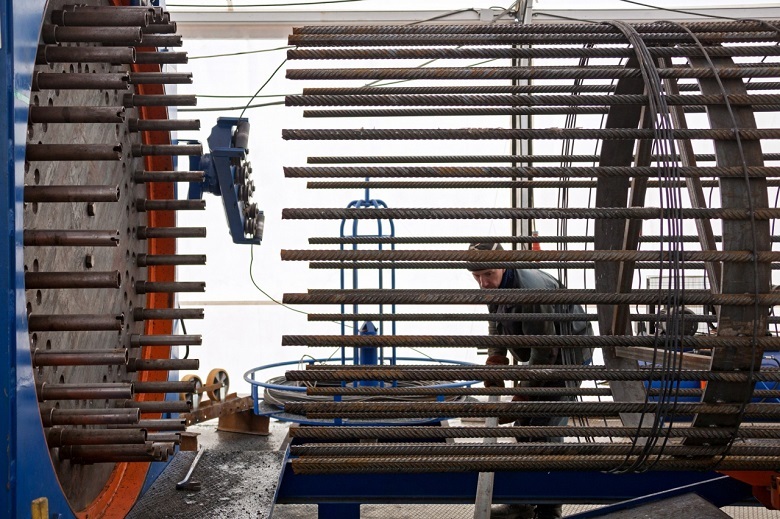
Armor frame preparation
Width increases bearing capacity. According to calculations, the average load on the piles is 2 545 Tc with a double margin of bearing capacity and strength.
Many consider that a pile is such an analogue of “legs”: a building rests on pile “limbs” like a person - on legs. This comparison is partly true. In the case of a pile-resistant support goes to the end of the structure. It is even called anatomically and affectionately - “heel”. For simple cases, heel work is enough.
In St. Petersburg, piles often have a length of no more than 20 meters. They abut the fifth layer of the moraine, which is a collection of rock fragments. It turns out well - and the pile is firmly rested, and the boulders do not need to be drilled and removed.
The pile becomes hanging when the main bearing capacity is provided not by the fifth, but by the sides due to the fact that friction arises between the side surface of the piles and the ground. In Lakhta Center, 85% of the load bearing load is provided by the side surfaces of the piles.

Scheme of load transfer by piles to foundation soils. A source
According to the results of calculations, the minimum draft will be 84.8 mm, the maximum - 121.9 mm for the entire period. The uniformity can be judged by the following figure - the base roll in relation to wind load - 0.00016. Sixteen hundred thousandths - this is not every technique you fix.
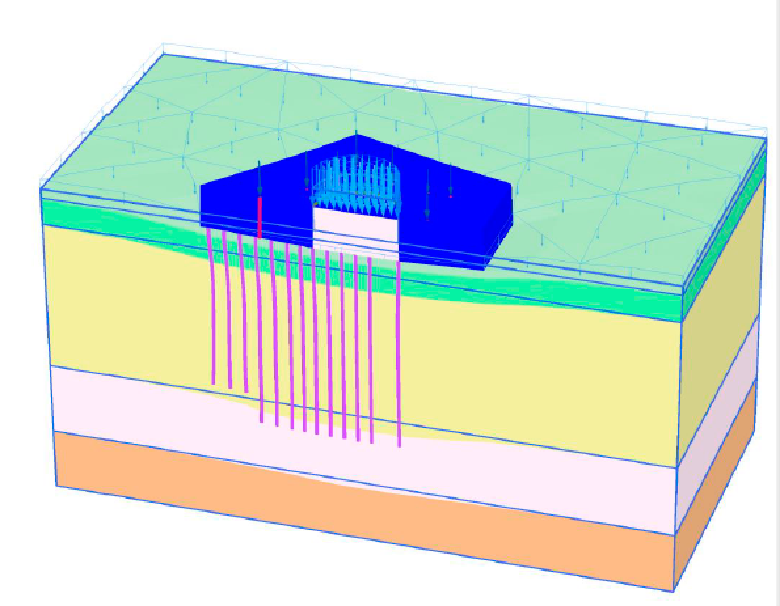
-
In the next post read about the manufacture of piles for "Lakhta Center": how not to lose direction while drilling? What to do with boulders? Where and why put the sensors in the piles? How was the shooting at a depth of 82 meters and what was there to shoot?
-
Consultant:
V.M. Lukin - Project Manager for reinforced concrete structures "Lakhta Center", Ph.D.

Feel uncomfortable? Do not rush to bypass the construction site along a radius of 500 meters. Let us figure out how to get a reliable support from what is in the "hanging" position.
- And what, potatoes? Do you think potatoes are so easy to cook and eat? Not here it was! From the potato you know how many dishes can be cooked? Well, consider: fried potatoes, boiled, mashed potatoes, french fries, potato shares. Potato patties with meat, mushrooms and so on. Potato pancakes, potato casserole, potatoes stewed with prunes, potatoes stewed with bay leaf and pepper, boiled young potatoes with dill, shangi ... (Devchata, 1961)
It was not by chance that I recalled this passage from an old Soviet film. How wrong are those who believe that a pile is a kind of “pillar”, simple and artless, like a potato tuber.
')
Today's piles are infinitely far from the great-grandfathers - wooden logs. They can be concrete, steel, reinforced concrete, combined materials. Hammer-in, indented, screwed in, drilled, stuffed, bored - in the way they get into the ground. They can be made in advance and loaded into the mine or manufactured directly in it. According to the method of work, the pile may be suspended or fixed. A modern pile is in itself a skillful engineering structure.

And you can still so. 1988 Experimental method of delivering piles to the ground - “shooting”, in this example - through the water. Army gun redeveloped for construction purposes. The depth of driving is increased 2-2.5 times per shot at “compared to using the same energy differently”.
Source of
And now let's complicate the task - piles work in a group - a pile field. Within the field, piling parameters may vary. The field recipe is prescribed by geotechnics - its own, in each individual case. In the case of the Lakhta Center Tower, a unique structure in the ground conditions of the third, most difficult category, this recipe was masterfully composed.

Fog over the pile field "Lakhta Center". 2013
Do you need piles?
For all the obvious answer, it is not obvious. High-rise buildings, in principle, can do without them. So far, the failed Ingria Tower skyscraper in St. Petersburg (165 m), which should be erected on Poklonnaya Hill, according to the project has no piles - only a slab. Of course, not from the good life: under the ground in this place is the zone of influence of the subway tunnels. Nevertheless, the company's calculations confirmed the reliability of the design, and later the decision was approved by Glavgosexpertiza.

The construction project has not been approved by Gosstroynadzor. Not because of the piles. The reason - the discrepancy Gradplan and "extra" underground floor. The authors of the project are “Tsaritsyn Architectural Studio”. Photo source
Maybe in Lakhta Center do without piles? Just make the slab more powerful and deeper?
The first thing geotechnics do when they receive the results of underground surveys is to answer this question. The verdict is unambiguous - building on a natural basis is impossible for Lakhta Center. Support layers - Vendian clay, located too deep. How not to deepen the base plate, they are still far away.
Even if the supporting layer was close - you can not do without piles. There is a reason.
What geotechnics fear
Any building gives a draft. The mechanics of the process are easy to imagine - you sit on the sofa and push the pillow.

The building and the ground also work
The draft itself is not a threat. Problems begin only when it passes unevenly. The nightmare of any geotechnical engineer is a roll or deflection of the foundation to a supercritical state.
In the case of a supertoll, rates are rising. Not just because of the height of the tower.
In Lakhta Center, as in most modern skyscrapers, the main element of the sustainability system is the core.

At the St. Petersburg tower it is reinforced concrete, very massive - the thickness of the wall is from 2.5 to 0.8 meters with thinning as it gains height. The diameter also decreases, the maximum radius is 26 meters at the base of the tower.
Most of the load on the foundation should fall on this 26-meter section.

The core of "Lakhta Center" at the foundation level. 2015
Saucer, soup plate or glass
The greatest pressure on the base - in the center, the least - on the edges. Solid base plate will sag. Of course, it will not turn into a “glass” - a supercritical state will occur at the “soup bowl” stage.
You can make the slab tougher - more reinforcement, more reinforced concrete, more strength! According to calculations, the required stiffness is achievable in a slab with a thickness of 8 meters.
There are no such monolithic slabs in the world. Skyscraper Messe Torhaus (Frankfurt) has 6-meter sections in the foundation. More such a feat no one repeated.

Messe Torhaus, 117 m. Photo Source
There is a reason that no one will ever make an 8 meter thick slab of concrete. Paradoxically, it simply will not be durable. This will occur due to the occurrence of cracks during the cooling of the concrete mix. It is hardly possible to control the process of exothermia on a monolith of such thickness.

Photos from instagrama Saratov plant concrete mixes. (The illustration is not a demonstration of the quality of the products of the plant - see instagram)
Messe was built in 1983-84, now there is a more effective technical solution - a box-like foundation. In order not to depart far from the pile theme, for the time being we simply take it as a fact - as a result, under the tower “Lakhta Center” the foundation is just that kind, box-shaped. How it works on the uniform distribution of loads, we will tell in a separate post.
Box-shaped foundation will not allow the plate to be like a soup bowl. But to achieve ideally the same pressure over the entire area of the base, he still can not afford. To prevent the "saucer" effect, a pile field enters the battle.
SYNCHRONIZATION SEDIMENTS
The first thing you need to know to create a uniform precipitation is how different areas are loaded under the base.
Let's look at the scheme.

Three load zones
The first surprise is that, thanks to the box-like foundation, under-center piles will now be under the center.
The zone of increased attention - the second, between the center and the periphery - a significant load from under the trunk of the building passed into this zone. Further - behind the contour of the building, on the periphery, the pressure weakens.
Now it is necessary to make so that all sites settle down synchronously. The orchestra will be conducted by geotechnics.
There are three parameters of piles that can be adjusted.
The first is the length. It increases the bearing capacity of the pile and slows the rate of precipitation. Behind the contour of the building are piles of 55 meters each. Inside - ten meters longer.
The second parameter is the pile pitch frequency. Under the core and in the periphery, it is equal to 5 meters. In the zone of concentration of the load "accelerates" to 3-4 meters.

Pile field under the tower. A dark badge denotes piles 65 meters long, 55 meters light.
The third is the width of the pile. It does not change - the diameter of all structures is 2 meters. These are the widest piles in the world.

Armor frame preparation
Width increases bearing capacity. According to calculations, the average load on the piles is 2 545 Tc with a double margin of bearing capacity and strength.
So what is a hanging pile
Many consider that a pile is such an analogue of “legs”: a building rests on pile “limbs” like a person - on legs. This comparison is partly true. In the case of a pile-resistant support goes to the end of the structure. It is even called anatomically and affectionately - “heel”. For simple cases, heel work is enough.
In St. Petersburg, piles often have a length of no more than 20 meters. They abut the fifth layer of the moraine, which is a collection of rock fragments. It turns out well - and the pile is firmly rested, and the boulders do not need to be drilled and removed.
The pile becomes hanging when the main bearing capacity is provided not by the fifth, but by the sides due to the fact that friction arises between the side surface of the piles and the ground. In Lakhta Center, 85% of the load bearing load is provided by the side surfaces of the piles.

Scheme of load transfer by piles to foundation soils. A source
What is more reliable - stand or hanging pile?
Most of the unique buildings with deep foundations are on hanging piles. You can bet - if you have a skyscraper and non-rocky ground in front of you - the probability of hanging piles is close to 100%.
But this does not mean that the piles are unreliable. The type of piles is determined by the characteristics of the building and the ground. Each type is good in its place.
Summary options
According to the results of calculations, the minimum draft will be 84.8 mm, the maximum - 121.9 mm for the entire period. The uniformity can be judged by the following figure - the base roll in relation to wind load - 0.00016. Sixteen hundred thousandths - this is not every technique you fix.

-
In the next post read about the manufacture of piles for "Lakhta Center": how not to lose direction while drilling? What to do with boulders? Where and why put the sensors in the piles? How was the shooting at a depth of 82 meters and what was there to shoot?
-
Consultant:
V.M. Lukin - Project Manager for reinforced concrete structures "Lakhta Center", Ph.D.
Source: https://habr.com/ru/post/402559/
All Articles